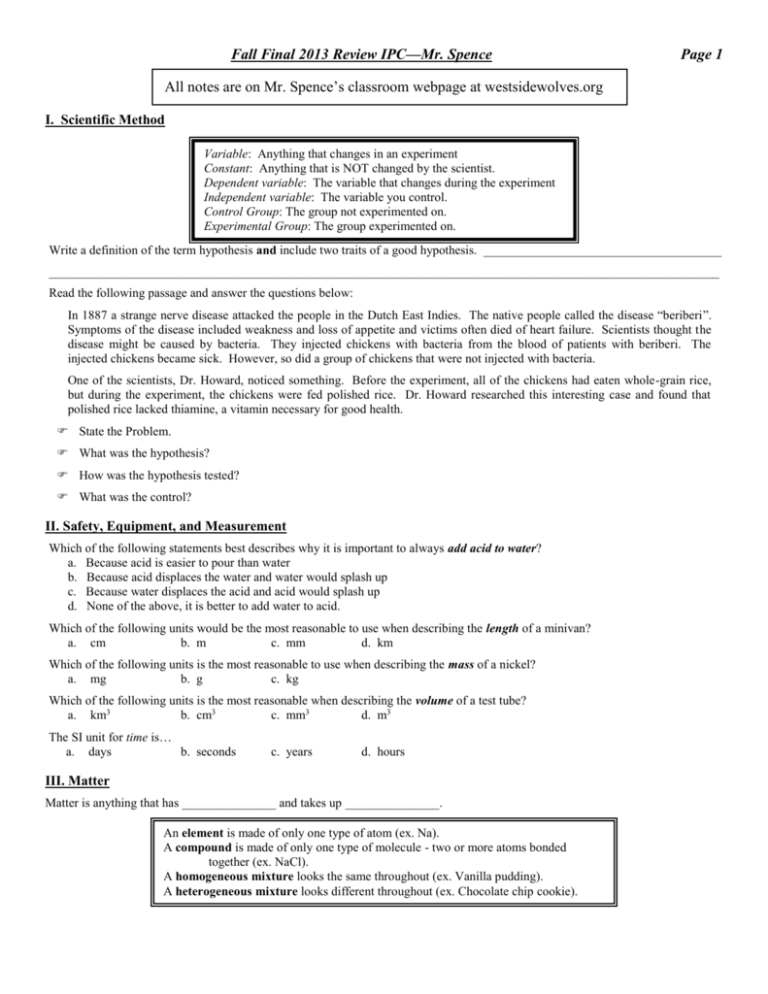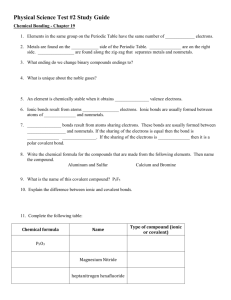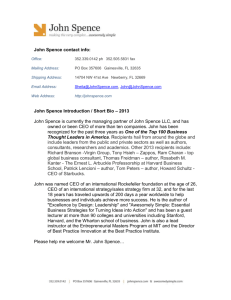Final Exam Review
advertisement

Fall Final 2013 Review IPC—Mr. Spence Page 1 All notes are on Mr. Spence’s classroom webpage at westsidewolves.org I. Scientific Method Variable: Anything that changes in an experiment Constant: Anything that is NOT changed by the scientist. Dependent variable: The variable that changes during the experiment Independent variable: The variable you control. Control Group: The group not experimented on. Experimental Group: The group experimented on. Write a definition of the term hypothesis and include two traits of a good hypothesis. ______________________________________ ___________________________________________________________________________________________________________ Read the following passage and answer the questions below: In 1887 a strange nerve disease attacked the people in the Dutch East Indies. The native people called the disease “beriberi”. Symptoms of the disease included weakness and loss of appetite and victims often died of heart failure. Scientists thought the disease might be caused by bacteria. They injected chickens with bacteria from the blood of patients with beriberi. The injected chickens became sick. However, so did a group of chickens that were not injected with bacteria. One of the scientists, Dr. Howard, noticed something. Before the experiment, all of the chickens had eaten whole-grain rice, but during the experiment, the chickens were fed polished rice. Dr. Howard researched this interesting case and found that polished rice lacked thiamine, a vitamin necessary for good health. State the Problem. What was the hypothesis? How was the hypothesis tested? What was the control? II. Safety, Equipment, and Measurement Which of the following statements best describes why it is important to always add acid to water? a. Because acid is easier to pour than water b. Because acid displaces the water and water would splash up c. Because water displaces the acid and acid would splash up d. None of the above, it is better to add water to acid. Which of the following units would be the most reasonable to use when describing the length of a minivan? a. cm b. m c. mm d. km Which of the following units is the most reasonable to use when describing the mass of a nickel? a. mg b. g c. kg Which of the following units is the most reasonable when describing the volume of a test tube? a. km3 b. cm3 c. mm3 d. m3 The SI unit for time is… a. days b. seconds c. years d. hours III. Matter Matter is anything that has _______________ and takes up _______________. An element is made of only one type of atom (ex. Na). A compound is made of only one type of molecule - two or more atoms bonded together (ex. NaCl). A homogeneous mixture looks the same throughout (ex. Vanilla pudding). A heterogeneous mixture looks different throughout (ex. Chocolate chip cookie). Fall Final 2013 Review IPC—Mr. Spence Page 2 Using the information above, label the following as element, compound, homogeneous mixture, or heterogeneous mixture. Dirt _______________ Pepsi _______________ Fertilizer (NH4) _______________ Fluorine (F) _______________ List 3 examples of a Physical Change. _________________________ _____________________ ___________________ _____________________ ___________________ List 3 examples of a Chemical Change. _________________________ Combustion is a _______________ change. (chemical or physical) List 3 examples of a Physical Property. _________________________ _____________________ ___________________ _____________________ ___________________ List 3 examples of a Chemical Property. _________________________ Solubility is a _______________ property. (chemical or physical) IV. The Atom e3 atomic number = # of electrons = # of protons e- Li P+NN P+NNP+ e7 Atomic mass An element’s name is represented by its _________________ ____________________. An atom has a nucleus containing six protons and eight neutrons and has six electrons orbiting the nucleus. This atom is an isotope of which element? a. silicon b. carbon c. magnesium d. calcium 1. Helium-3 has an atomic # of _____, an atomic mass of ______, ______ electrons, ______ protons, and ______ neutrons. 2. Electrons are found in the _______________. They have a _______________ charge. 3. Protons are found in the _______________. They have a _______________ charge. 4. Neutrons are found in the _______________. They have a ______________ charge. 5. Most of the mass of an atom is found in the _____________________. 6. Isotopes have the ________________ number of protons but a __________________ number of neutrons. V. Periodic Table Columns are called ___________. Elements in a group have the same # of __________________ ____________________. Fall Final 2013 Review IPC—Mr. Spence Page 3 Rows are called _______________. They tell us the # of ________________ ______________. 1 -------------------- Valence ------------------------------------------- 3 +2 ---------------- Oxidation ----------------------------------- +3 8 -3 -2 On the above periodic Table, color: Metalloids – Blue, Transition Metals – Green, Noble Gasses – Red (or outline, shade and label each section, draw stars on the Metalloids) Sodium and Potassium are in the same (group / period). Circle one!! Group 2 Period 4 is the element ________. Chlorine has ____ electrons in its valence shell (outer energy level). Helium has ____ electrons in its valence shell. Potassium has ____ electrons in its valence shell. The oxidation number for Carbon is _____. ____ valence number A) Refers to number of electrons an atom will gain, lose or share. ____ oxidation number B) Atoms are most stable with 8 outer electrons. ____ octet rule C) Number of electrons in an atom’s outer ring. Elements found in which shaded area of this periodic table undergo the fewest chemical reactions? a. b. Q R c. d. S T Why do the Nobel Gases not form compounds? What is a valence electron? Fall Final 2013 Review IPC—Mr. Spence Page 4 VI. Bonding Define covalent bond: __________________________________________________________________________ Define ionic bond: _____________________________________________________________________________ Define ionic compound : ________________________________________________________________________ Circle the ionic compounds C2H12O6 KCl AgCl2 MgO P2 O6 SO4 Now make 2 ionic compounds of your own: _______________________________ Label each as ionic or covalent. A) KCl B) NF3 Criss-Cross Method Na 1+ _______________________________ C) O2 Write the formula and name (see below for naming help): 1. K Br Formula: _____________ Name: _________________ O 2- 2. Li S Formula: _____________ Name: ________________ 3. Barium Chloride ________________ Formula: Na2O 4. Sodium Nitride _________________ Name: Sodium Oxide Naming Binary Ionic Compounds: Remember: When naming binary ionic compounds (only two elements), name the metal first, then name the nonmetal, but change the ending to –ide. For example, NaCl would be sodium chloride, not sodium chlorine. Also, when naming these compounds, the subscripts do not matter! Practice: MgO ________________________________ BaF2 ________________________________ CaCl2 ________________________________ KI ________________________________ Li2O ________________________________ AlN ________________________________ Na2S ________________________________ In a neutral compound the total number of_______ charges and ______ charges of ions add up to _______. A chemically stable compound has a ___________ outer energy level. (Full / empty) VII. Law of Conservation of Mass & Chemical Reactions Fill in the blanks in the definition The Law of Conservation of Mass says __________ cannot be created or destroyed. Therefore, the mass of the products must _______________ the mass of the reactants. 2HCl + CaCO3 CaCl2 + CO2 + H2O coefficient reactants products subscript Fall Final 2013 Review IPC—Mr. Spence Page 5 If you have 30 grams of reactants (total), how many grams of products must you have? For: 2H2O + O2 -----------> 2H2O2, Name the reactants ______________________ Name the products ___________________ Balance the following equations. A) ____ H2 + _____O2 _____ H2O B) ____ Fe + _____ O2 _____Fe2O3 C) ____ Cl2 + _____ KI _____ KCl + _______ I2 Define Catalyst: (textbook pp. 373-374) ___________________________________________________________________________ Define Endothermic: __________________________________________________________________________________________ Define Exothermic: ___________________________________________________________________________________________ Label as synthesis, decomposition, single replacement, double replacement, or combustion. AB + CD ---------> AB AD + CB _______________________ -----------> A + B _______________________ A + BC ----------> AC + B _______________________ CH4 + 2O2 --------> CO2 + H2O _______________________ 2H2 + O2 -----------> 2H2O _______________________ Fe + CuCl2 --------> FeCl2 + Cu _______________________ 2KClO3 ------------> 2 K Cl + 3O2 _______________________ NaS + ZnNO3 -------> NaNO3 + ZnS _______________________ VIII. Changes of State (Phase Changes) Which of these states of matter is most commonly found in the universe? A. Plasma C. Liquid B. Solid D. Gas Fill in the following table with the correct information. Volume = Definite or Not Definite Shape = Definite or Not Definite KE = Very Quickly, Quickly or Slowly State Gas Liquid KE of Particles Volume Shape Fall Final 2013 Review IPC—Mr. Spence Page 6 Solid Label as solid, liquid, or gas. ___________________________ - Molecules have very little energy and stay close together. Keeps same mass and volume. __________________________ - Molecules have lots of energy and move freely around. Keeps same mass but changes volume. ___________________________- Molecules move some. Can change shape but keeps same volume. List the phases of water in order, from the phase with the lowest kinetic energy (heat) to the phase with the greatest kinetic energy (heat). A. Gas-Liquid-Solid B. Liquid-Solid-Gas C. Solid-Liquid-Gas D. Gas-Solid-Liquid IX. Density Density = Mass / Volume Units of density = g/mL Units of mass = grams Units of volume = mL, cm3 A wooden block has a mass of 5.1g and has the dimensions of 2cm x 2cm x 1.5 cm. What is the block’s density? A copper bracelet has a density of 9.0 g/mL. The mass is 6 g. What is the volume? Salt has a density of 1.56 g/mL. You have a teaspoon of salt with a volume of 20 mL. What is the mass of the salt? A block has a density of 1.3 g/mL. The block is broken into 60 identical pieces. What is the density of each block? X. Buoyancy and Viscosity Buoyancy: The upward force on an object that keeps it afloat. Viscosity: The thickness of a liquid. The more viscous, the slower it flows. A steel boat has a density much greater than water. It remains afloat because it displaces a mass of water __________________ _______________ the mass of the boat. Which substance has the lowest viscosity? (circle it!) Substance Substance L Substance M Substance N Flow Rate (cm/sec) 0.4 20.0 1.0 Fall Final 2013 Review IPC—Mr. Spence Page 7 XI. Solutions A solution is a homogeneous mixture of 2 or more substances. In a solution, a solute is dissolved in a solvent. The solute must be soluble to dissolve. Water is often known as the universal solvent because it dissolves all polar substances. The following containers all have liquid mixtures in them. Identify them as a solution, colloid, or suspension, AND give two reasons why for each one. (ex., homogeneous, nothing settled out, etc.) When I make Kool-Aid, the sugar is the ______________ and the water is the _____________. Give two examples of things that are insoluble in water. _______________________________________ _____________________________________ What is the solvent in an aqueous solution? What is the solvent in a tincture solution? Saturated _____ Unsaturated _____ Supersaturated _____ A. B. C. My lemonade does not contain as much dissolved sugar as it possibly could. It is ______________________. La King’s Candy Factory on The Strand in Galveston makes fudge and rock candy. They do this by making the solution hold more dissolved sugar than is normally possible. These solutions are __________________________________. How do these factors affect the solubility of solids and gases in liquid? (increase, decrease, or no affect) Temperature Particle Size Stirring Solid in Liquid Gas in Liquid Pressure Fall Final 2013 Review IPC—Mr. Spence Page 8 An alloy of bronze is 95% copper and 5% zinc. The solute is the __________. In a cup of sugar water, the solvent is the ______________. Why is water called the Universal Solvent? Describe in words and label the picture. What does it mean for a molecule to be polar? If you have not already, add this information to the water molecule pictured above. Which of the substances below would not be water soluble? (circle it!) Substance X Substance F Polar Non-Polar When using the light bulb set up (see picture) to test for conductivity and electrolytes, identify if you have a nonelectrolyte, weak electrolyte, or strong electrolyte when you see… A bright light A dim light No light at all XII. Solubility Graphs 1) Use the graph to answer the questions. At 40oC, how many grams of KNO3 are needed to saturate 100 grams of water? At 20oC, will 60 grams of Na2SO4 be saturated, supersaturated, or unsaturated in 100 grams of water? Which 2 substances have the same saturation point at approximately 50oC in 100 grams of water? Which substance is the gas?






